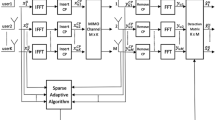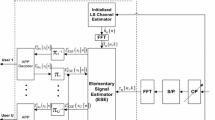Abstract
This paper proposes channel prediction algorithms, based on the vector Prony method, tackling the channel state information (CSI) acquisition problem in fast time-varying uplink and downlink channels of the time division duplex (TDD) in massive multiple-input, multiple-output (MIMO) systems. For the uplink system, we show that the CSI obeys the Prony equation in theory, and we aim to overcome the instability of solving the Prony equation via iterating the Prony coefficients based on CSI re-estimated from signals received during data transmission. For the downlink system, a method to generate precoders is constructed based on the prediction of downlink CSI. Experiments are performed according to the fast fading full-dimensional multiple-input multiple-output (FD-MIMO) channel model of 3GPP Standards. The results demonstrate that performance is improved remarkably in uplink transmissions and approaches the theoretical optimal scheme in downlink transmissions.







Similar content being viewed by others

Data Availibility Statement
The datasets generated during and/or analysed during the current study are available from the corresponding author on reasonable request. All results are included in this published article; the results raw output is available from the corresponding author on reasonable request.
Code Availability
Code is available from the corresponding author on reasonable request.
Abbreviations
- CSI:
-
Channel State Information
- TDD:
-
Time Division Duplex
- MIMO:
-
Multiple-input Multiple-output
- FD-MIMO:
-
Full-Dimensional Multiple-input Multiple-output
- AR:
-
Autoregressive
- SOS:
-
Sum-Of-Sinusoids
- FIR:
-
Fnite Impulse Response
- PAD:
-
Prony-based Angular-delay Domain
- MU:
-
Mobile User
- 3GPP:
-
3Rd Generation Partnership Project
- BS:
-
Base Station
- UL:
-
Uplink
- DL:
-
Downlink
- AOA:
-
Azimuth Of Arrival angle
- AOD:
-
Azimuth Of Departure angle
- ZOA:
-
Zenith Of Arrival angle
- ZOD:
-
Zenith Of Departure angle
- MMSE:
-
Minimum Mean Square Error
- LOS:
-
Loss Of Sight
- ASA:
-
Azimuth Spread of Arrival angle
- ASD:
-
Azimuth Spread of Departure angle
- ZSA:
-
Zenith Spread of Arrival angle
- ZSD:
-
Zenith Spread of Departure angle
- ML:
-
Maximum Likehood
- QAM:
-
Quadrature Amplitude Modulation
- SNR:
-
Signal Noise Ratio
- DMRS:
-
Demodulation Reference Signal
References
Shaik, N., Malik, P. K. (2022). 5G massive MIMO-OFDM system model: Existing channel estimation algorithms and its review. In Smart antennas. EAI/Springer innovations in communication and computing (Springer).
Duel-Hallen, A., Hu, S., & Hallen, H. (2000). Long-range prediction of fading signals: Enabling adaptive transmission for mobile radio channels. Special issue on advances in wireless and mobile communications. IEEE Signal Processing Magazine, 17(3), 62–75.
Duel-Hallen, A. (2007). Fading channel prediction for mobile radio adaptive transmission systems (invited paper). Proceedings of The IEEE, 95(12), 2299–2313.
Heidari, A., Khandani, A. K., & McAvoy, D. (2010). Adaptive modeling and long-range prediction of mobile fading channels. IET Communications, 4(1), 39–50.
Chen, M., & Viberg, M. (2009). Long-range channel prediction based on nonstationary parametric modeling. IEEE Transactions on Signal Process, 57(2), 622–634.
Truong, K. T., & Heath, R. W. (2013). Effects of channel aging in massive MIMO systems. Journal of Communications and Networks, 15(4), 338–351.
Papazafeiropoulos, A. K., & Ratnarajah, T. (2015). Deterministic equivalent performance analysis of time-varying massive MIMO systems. IEEE Transactions on Wireless Communications, 14(10), 5795–5809.
Kong, C., Zhong, C., Papazafeiropoulos, A. K., Matthaiou, M., & Zhang, Z. (2015). Sum-rate and power scaling of massive MIMO systems with channel aging. IEEE Transactions on Communications, 63(12), 4877–4893.
Adeogun, R. O., Teal, P. D., & Dmochowski, P. A. (2015). Extrapolation of MIMO mobile-to-mobile wireless channels using parametric-model-based prediction. IEEE Transactions on Vechicular Technology, 64(10), 4487–4498.
Fu, L., Wang, Q., Huang, Y., & Yang, L. (2016). Performance analysis of low-complexity channel prediction for uplink massive MIMO. IET Communications, 10(14), 1744–1751.
Peng, W., & Jiang, M. T. (2017). Channel prediction in time-varying massive MIMO environments. IEEE Access, 5, 23938–23946.
Derevianko, N., & Plonka, G. (2021) Exact reconstruction of extended exponential sums using rational approximation of their Fourier coefficients. arXiv preprint arXiv:2103.07743
Yin, H., Wang, H., Liu, Y., & Gesbert, D. (2020). Addressing the curse of mobility in massive MIMO with Prony-based angular-delay domain channel predictions. IEEE Journal of Selected Areas in Communications, 38, 2903–2917.
Technical Specification Group Radio Access Network; Study on 3D channel model for LTE (release 12), document TR 36.873 V12.7.0, 3rd Generation Partnership Project (2017)
Hou, X., & Kayama, H. (2011). Demodulation reference signal design and channel estimation for LTE-advanced uplink. In M. Almeida (Ed.), Advances in vehicular networking technologies. IntechOpen.
Funding
This work was not supported by funding from any source.
Author information
Authors and Affiliations
Contributions
Yi Huang, Haiquan Wang, Haifan Yin, and Zhijin Zhao conceived the algorithm and designed the experiments; Yi Huang and Haiquan Wang designed the MATLAB programs; Yi Huang and Haiquan Wang performed the experiments; Yi Huang prepared figures and analyzed the experimental results; Haiquan Wang drafted the manuscript; Yi Huang, Haifan Yin, and Zhijin Zhao revised the manuscript. All authors read and approved the final manuscript.
Corresponding author
Ethics declarations
Conflict of interest
The authors declare that they have no Conflict of interest.
Additional information
Publisher's Note
Springer Nature remains neutral with regard to jurisdictional claims in published maps and institutional affiliations.
Rights and permissions
Springer Nature or its licensor (e.g. a society or other partner) holds exclusive rights to this article under a publishing agreement with the author(s) or other rightsholder(s); author self-archiving of the accepted manuscript version of this article is solely governed by the terms of such publishing agreement and applicable law.
About this article
Cite this article
Huang, Y., Wang, H., Yin, H. et al. Iterative Time-Varying Channel Prediction Based on the Vector Prony Method. Wireless Pers Commun 136, 103–122 (2024). https://doi.org/10.1007/s11277-024-11162-8
Accepted:
Published:
Issue Date:
DOI: https://doi.org/10.1007/s11277-024-11162-8



